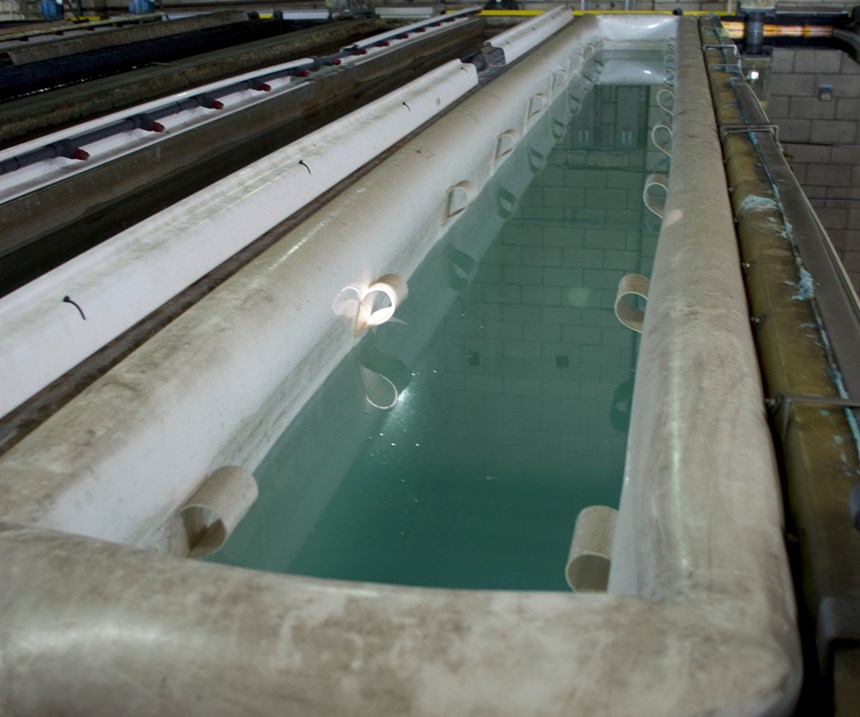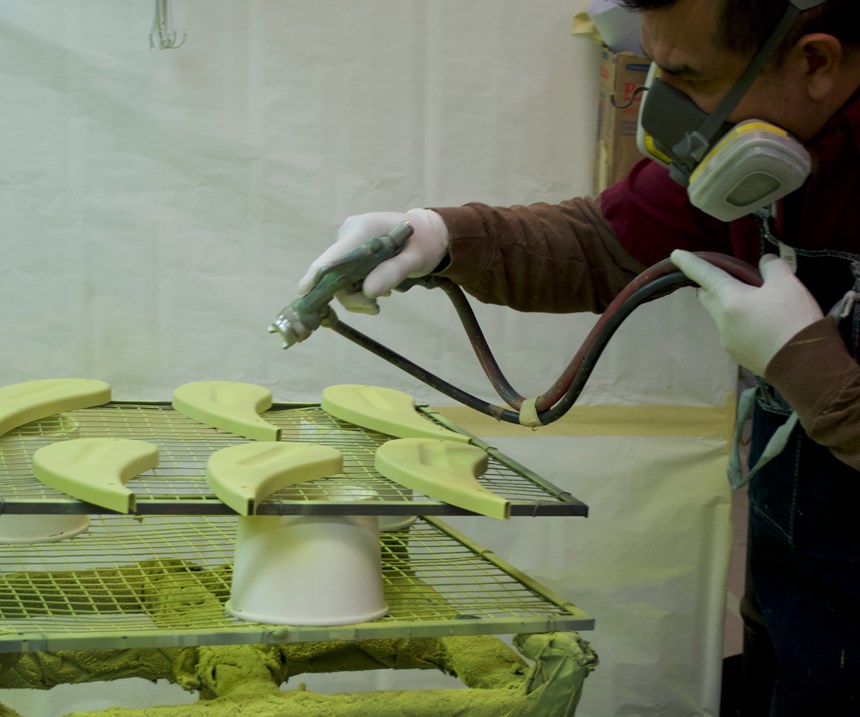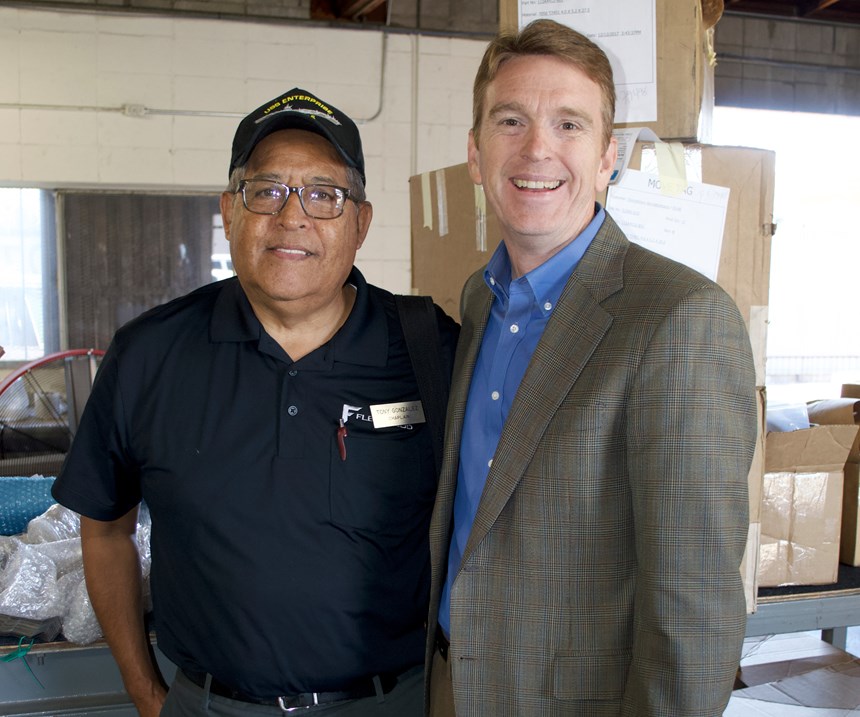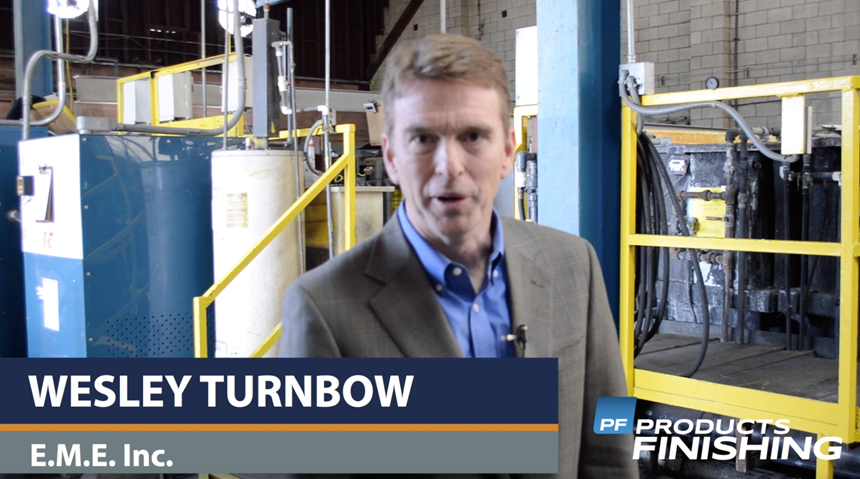Call Wesley Turnbow “the reluctant finisher.”
While the CEO of EME Inc. in Compton, California, now happily oversees a 125,000-square-foot anodizing and liquid coating facility on a sprawling 3 acres that has made its mark in aerospace coatings—especially in titanium anodizing, which is performed by only a few shops—Turnbow never expected to be sitting in the owner’s chair of the company his father founded several decades ago.
Featured Content
Nor did Turnbow ever expect to become the leader of the Metal Finisher’s Association of Southern California (MFASC), which has weathered a barrage of attacks to the industry from numerous regulatory agencies in the Los Angeles area.
And neither did he plan to run for Long Beach city council, which he did more than a year ago, having felt called to serve his community. In the process, he walked every street in the district to get to know his possible constituents and the issues they faced.
In fact, until a couple of decades ago, Turnbow was content with his accounting and law degrees, working at a prestigious financial services firm. He and his wife, Michelle, were on their way to raising six children and travelling the world on mission trips for their church.
But almost 18 years ago, his father, Randy, called to say his controller at EME had left and they needed to have a discussion about the future of the family-owned company that employed well over 100 people, many of whom lived in the Compton area.
From CPA to Finisher
“It was a frank discussion,” Turnbow says. “I was in my fifth year at Price-Waterhouse, and I was advancing quickly. We had just had our first child. I remember going to one of the partners and asking their advice, and they told me about being at their kid’s Little League games and being on a laptop, and I was like ‘that’s the wrong story to tell me.’”
He went back to his father and told him what he was earning as a CPA at the firm, to which his father replied, “That’s crazy,” and then told him what he had been paying his controller. Turnbow remembers asking his father, “Who would work for that?”
Eventually, Turnbow left the corporate job and joined EME as chief financial officer. His dad is still chairman, and his uncle Steve is president. His younger brother, Dalton, joined the operation soon after he did.
“After joining, I realized everyone had to get along,” Turnbow says with a laugh. “That is never easy. It takes a lot of humility, but it’s been great. Having my brother happy to be working for me is amazing, and having my uncle happy working for me is even more amazing. It has all worked out very well.”
It certainly seems to have worked out well. Over the last 50 years, EME has made a name for itself in the aerospace, military and commercial industries, with primary services that include aluminum anodizing and chemical film processes, along with various coatings for titanium, steel, stainless steel, brass and the difficult magnesium substrate. The company specializes in primer and topcoat applications in a 10,000-square-foot paint shop, one of the three paint areas in the facility, which allows for maximum speed and versatility for parts.
Anodizing Super Line
The heart of the operation is a digitally controlled, 24-foot anodizing and chemical film line that processes both yellow and clear films, as well as sulfuric and boric-sulfuric anodizes. Soon, this line also will boast one of the largest hard-anodize tanks in California.
Next to it is what Turnbow calls a “super line,” a titanium and stainless steel processing operation that he says is one of a kind in the finishing industry. “With this line, we can clean and etch parts up to 16 feet,” he says. “In addition, we have blasting rooms that can use any media of your choice, such as plastic, aluminum oxide or garnet, on parts up to 24 feet.”
EME’s most recent expansion is a large titanium anodize line that processes parts for customers such as Lockheed, Boeing and Sikorsky. It is a system that Turnbow’s father put in before he retired from the company. Turnbow says it was a real treat to see his dad in action.
“It was great to see him in entrepreneurial mode,” he says. “He had tracked down this really great formula that was being used in Russia to anodize titanium, and then he and my uncle really experimented on the process and worked it until they finally were able to get approvals from Northrup and Lockheed.”
The new line gave EME inroads to doing work on the Lockheed Martin F-35 Lightning II, a single-seat, single-engine, all-weather, stealth, multi-role fighter that the manufacturer says is designed to perform ground-attack and air-superiority missions.
Today, about 50 percent of all EME sales are from liquid spray and topcoats, and around 30 percent come from the anodizing operation. The remaining 20 percent are from non-destructive testing and other operations the shop performs. It has approvals from Airbus, B.F. Goodrich–Rohr/UTC Aerospace Systems, Boeing, Cessna Aircraft, Embraer, FACC, General Dynamics, Gulfstream Aerospace, Hawker Beechcraft, Helicopter Technology, Lockheed-Martin, MD Helicopters, Northrop-Grumman and Triumph Group/Vought Industries.
MFASC Leadership Amidst Regulatory Battles
As Turnbow has become more actively involved in the EME operations over the past two decades, so has his involvement grown in the Southern California finishing world, including leadership roles in the MFASC and its ongoing battles with regulators. In particular, the South Coast Air Quality Management District (AQMD) has targeted plating operations at the behest of community and political leaders.
The scrum came to a head in the summer of 2017, when the AQMD announced it would monitor the air quality around EME and nearby Morrells Electro Plating for hexavalent chromium, even though the agency’s attorney said there was no evidence of high levels of the carcinogen in readings of the area’s air. The AQMD still placed five portable monitors upwind and downwind from the two facilities, and collected samples every three days.
It was around that time that Turnbow was elected president of the MFASC, which led him to wear two hats: first as a shop owner being targeted by the AQMD and second as the leader of the association considered the face of the plating industry in Southern California.
“What was happening to all of us in the finishing industry was based solely on poor science,” he says. “Everything hinged on one really bad study. We took as much information as we could and told them that no one was relying on this bad 1975 study based on a 1930s facility. They couldn’t even break out hex chrome in the study. They simply guessed at it.”
The Compton area was the first area targeted by a new AQMD multi-year initiative for monitoring air emissions at the roughly 117 chromium plating and anodizing plants the agency said was in its jurisdiction. Enforcement began following the AQMD’s work in the nearby city of Paramount, where it reached agreements with two of that city’s processors that will force them to close their chromium-related operations if emissions ever exceed a certain level.
Eventually, politicians from Los Angeles and surrounding communities used the hex-chrome air issue as a platform to engage constituents and spur protests against the finishing operations.
“I blame the AQMD for shooting themselves in the foot and saying there was a problem when there really wasn’t an issue,” Turnbow says. “Then the politicians went after AQMD to do even more, and its hand was forced. They started doing this weird enforcement stuff, and it was really over the top.”
For example, when AQMD reported a high reading for hex-chrome in the area on a particular day, it would request to put air monitors inside the plating shops—in fact, next to a plating line. That was crossing a line that EME and other plating shops would not freely allow. Eventually, AQMD secured a warrant to put a temporary monitor in Morrells’ facility, but the agency was found to be in violation of the warrant both for bringing unauthorized agencies into the shop and for continuing to do so after the warrant’s time limit.
It was a turbulent time for the MFASC and for Turnbow, who also was leading the National Association for Surface Finishing chapter, as it did not have an official executive director. Bryan Leiker of K&L Anodizing had been performing a lot of the administrative and membership functions for the group in a part-time role, and Turnbow also spent a considerable amount of time steering the MFASC while it was under what it felt was “considerable attack.” Defending itself was draining not only member companies’ personnel resources, but it also took a huge toll financially on the chapter, as it had to engage attorneys, experts and even a public relations firm to help it deal with the fallout from the AQMD battles.
“When we lost our executive director, that was the driving reason that I stepped in as president of the association,” Turnbow says. “I wanted to make sure we had good leadership and to help Bryan with what he was doing for the group, which has been exceptional. It was a very short-term thing, and now that Bryan is serving as essentially the executive director, the board is very pleased with the direction of things.”
Good Growth and Good Employees
Turnbow says business picked up for EME late in 2017 and has been strong through the first part of this year, a good sign that the aerospace industry is healthy and that the finishing industry is following suit. He attributes much of the company’s success to its employees.
“I’m super proud of the employees we have here,” he says. “They’ve done a great job, and we owe it all to them. They live right around the Compton area, and we’re happy to have all of them.”
One in particular he singles out is John Lopez Jr., EME’s quality manager, who was hired out of high school and has worked his way up in the company to become one of the most knowledgeable managers in the industry, according to Turnbow.
“We got him from In-N-Out Burger, and he’s the best there is,” Turnbow says. “The customers and the primes we work with know how good he is. He started out in customer service and worked his way up, and he lives in this neighborhood. I’m so happy to have a guy like him.”
The CPA and lawyer-turned-finisher also is happy that things for the MFASC have turned a corner and that its leadership is dealing more effectively with regulators. Now he can focus more on his company and on raising his six children.
After all, “I love raising my kids more than I do running this company,” he says with a smile.
For information on EME Inc., visit emeplating.com.
RELATED CONTENT
-
How to Maximize Nickel Plating Performance
The advantages of boric acid-free nickel plating include allowing manufacturers who utilize nickel plating to keep up the ever-changing regulatory policies and support sustainability efforts.
-
Best Plating Practices for the Application of Brush Plated Zinc-Nickel
Brush plating is an industrial electroplating process designed for demanding OEM and repair applications, without the use of an immersion tank. This presentation demonstrates the best practices for brush plating zinc-nickel to meet the ASTM standards of hydrogen embrittlement and corrosion protection. From preparatory steps to the application of a trivalent chromium conversion coating, the proper plating techniques needed to meet the customers’ demanding requirements are discussed.
-
Selecting PPE for Your Paint Shop
Guidelines for determining the appropriate personal protective equipment for a painting operation.

























